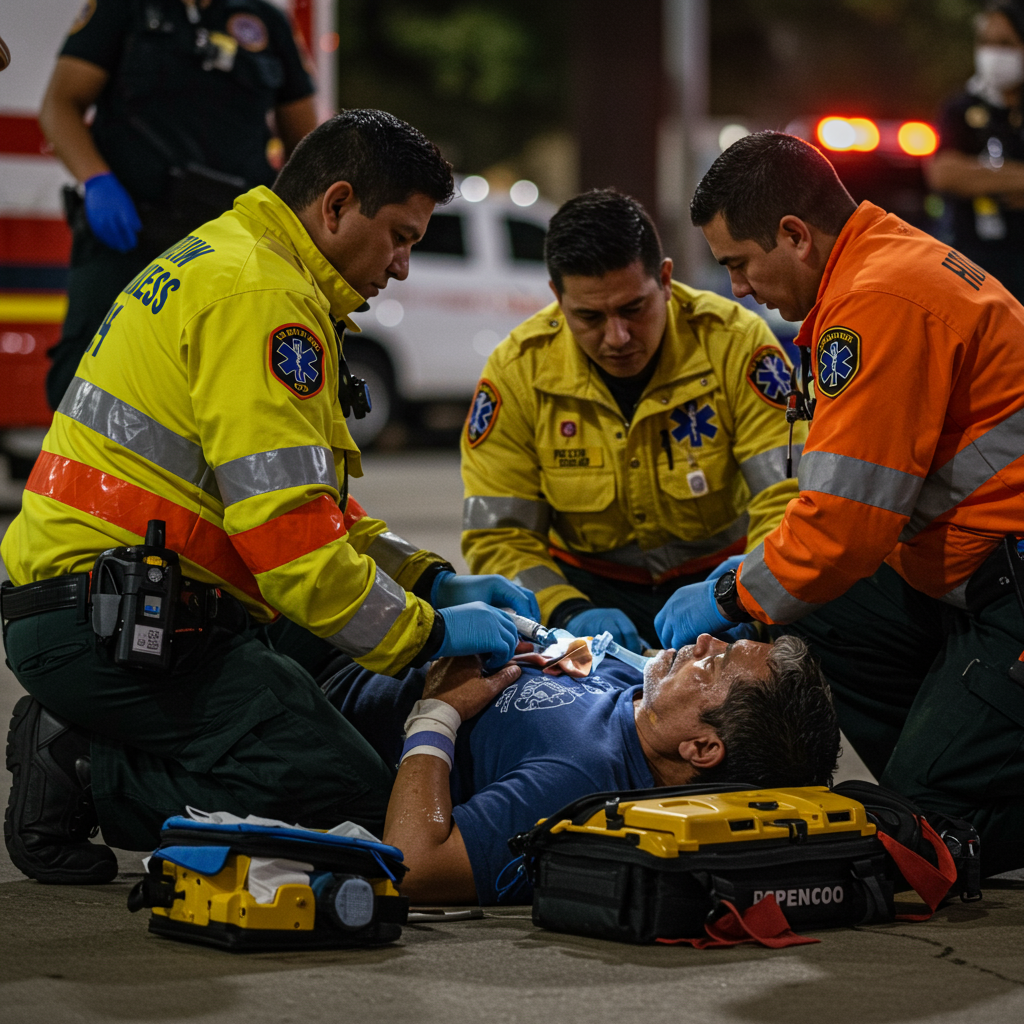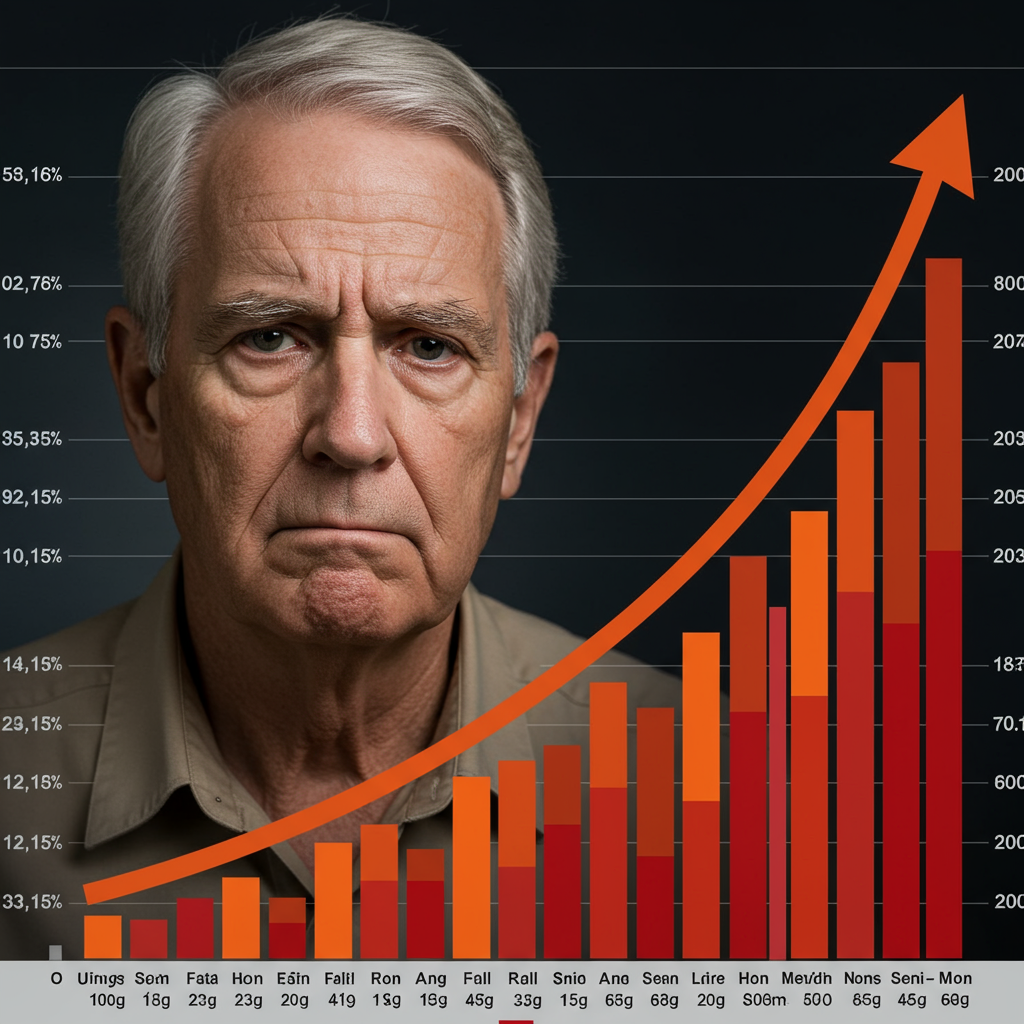Waking up with a pounding head and blurry vision often feels like the aftermath of a night out. But for 61-year-old Nestor Montalvo, these familiar “hangover” symptoms signaled something far more serious: a life-threatening stroke. When he collapsed trying to stand, the immediate 911 call and rapid paramedic response were the first critical steps in a fight for survival that highlights the urgent need to recognize stroke signs, even when they mimic less severe conditions. His harrowing experience underscores a vital message: time is critical when the brain is under attack.
A Seemingly Innocent Morning Turns Critical
Last September, Nestor Montalvo awoke experiencing what he initially dismissed as a really bad hangover. He had a significant headache, and his vision was not clear. The only problem? He hadn’t consumed any alcohol the previous day. The situation escalated dramatically when he attempted to get out of bed.
The right side of his body felt numb. Everything around him started spinning uncontrollably. When he tried to stand, he immediately fell to the floor. Confused and unable to understand what was happening, he relied on his wife, who quickly recognized the severity of his condition. She didn’t hesitate; she immediately dialed 911.
Paramedics Deliver a Frightening Diagnosis
The emergency medical responders arrived swiftly. After a quick assessment, they delivered alarming news that instantly shifted the situation from concerning to critical: Nestor was having a stroke. This swift, on-the-spot diagnosis by the paramedics was crucial. They wasted no time, rushing him directly to the emergency room at Catholic Health’s Mercy Hospital, located in Nassau, Long Island.
The severity of his condition became starkly apparent upon arrival. Nestor recalled overhearing a conversation between a doctor and his daughter, who is a registered nurse. The doctor stated that his chances of survival were tragically low – only about 15%. This moment brought the terrifying reality into sharp focus. “I was like, ‘Oh my God, I’m going to die,'” Montalvo recounted, the fear palpable as he thought he might not have a chance to say goodbye to loved ones.
Understanding the “Time Is Brain” Principle
Doctors who specialize in treating strokes often use a critical phrase: “Time is brain.” This principle, highlighted by experts like Dr. Taylor Kimberly, chief of neurocritical care at Massachusetts General Hospital, means that every minute a stroke goes untreated, more brain cells are damaged or lost. Strokes occur when the brain’s blood supply is interrupted. This interruption happens either because a blood vessel is blocked (an ischemic stroke) or because a blood vessel ruptures (a hemorrhagic stroke).
Nestor experienced an ischemic stroke, the more common type, caused by a blockage. In this scenario, vital oxygen and nutrients cannot reach parts of the brain. This deprivation rapidly leads to cell death and neurological damage. The longer the blockage persists, the more extensive and potentially irreversible the damage becomes. Doctors at Mercy Hospital faced the challenge of determining how long Nestor had been experiencing symptoms since they were present when he woke up.
Rapid Hospital Response to a Neurological Emergency
Dr. Cini Thayil, an emergency medicine attending at Mercy Hospital, was among the first physicians to evaluate Nestor. She noted his “very prominent” neurological deficits immediately, confirming that something was significantly wrong. Her observation triggered the hospital’s established stroke protocol, a streamlined process designed to minimize delays in critical stroke treatment.
The system worked with impressive speed. Within just 10 minutes of arriving at the emergency room doors, Nestor was assessed as a potential stroke patient. A CAT scan was performed only 15 minutes later. These rapid diagnostic steps allowed the medical team to quickly visualize the brain and identify the blockage. Soon after reviewing the scans and conferring, doctors administered a powerful clot-busting medication known as TNK. This drug is designed to dissolve the blood clot causing the ischemic stroke. Following the medication, Nestor underwent a minor procedure to ensure the clot had been completely cleared. This rapid sequence of assessment, diagnosis, and treatment was paramount to his survival.
The Challenging Path of Stroke Recovery
While the immediate stroke treatment successfully saved Nestor Montalvo’s life, it was only the beginning of an incredibly demanding journey. Surviving the initial event was miraculous, but the stroke had left significant damage that required extensive rehabilitation. Nestor faced severe complications; his vocal cords collapsed, necessitating a tracheotomy to allow him to breathe. This tube also meant he could not speak or swallow normally. The stroke itself also impaired his ability to control the muscles needed for speech and eating.
When he began working with Aileen Fairchild, an acute care speech pathologist at Mercy Hospital, his challenges were profound. He could not even manage to swallow a quarter-teaspoon of applesauce without assistance. “It was a mess,” Montalvo recalled, detailing the frustration of being unable to talk, swallow, or eat independently.
Intensive Rehabilitation Efforts
For six weeks, Aileen Fairchild dedicated focused therapy sessions to Nestor’s recovery. He received approximately an hour of speech therapy daily. This included not only exercises aimed at regaining speech but also targeted physical exercises for the muscles in his throat essential for eating and swallowing. Regular scans were conducted to monitor the progress of the treatments and guide further steps.
After a month and a half of this intensive work, a significant milestone was reached: the tracheotomy tube was removed. This allowed Fairchild and Montalvo to intensify their focus on improving his ability to eat and speak without the obstruction of the tube. He underwent three additional medical procedures designed to further assist the muscles in his throat in regaining function. The hard work paid off; by Thanksgiving, just a few months after his stroke, Nestor was able to share and enjoy a regular meal with his family, a moment of immense progress and emotional significance.
Life a Year Later: Reflecting on the Journey
Today, roughly a year after that terrifying morning, Nestor Montalvo has made remarkable progress in his recovery. He has regained his ability to speak and eat, allowing him to fully enjoy his retirement. He spends cherished time with his wife, children, grandchildren, and their dog, Paris. While his recovery continues, he still uses a cane for stability when walking and remains committed to outpatient physical therapy.
Montalvo openly shares that the process of rehabilitation has, in many ways, felt even more challenging than surviving the stroke itself. The physical and emotional toll of relearning basic functions is immense. His experience has fundamentally changed his perspective on life. “You take life for granted, and then when something like this happens, it wakes you up,” he reflected. Like many, he thought serious health events were things that happened to other people. “You hear people talk about it, and it just sounds like it’s not going to happen to you. All of a sudden, it happens to you.”
Strokes Are Not Just for Older Adults
Nestor’s story serves as a powerful reminder that stroke can affect anyone, regardless of age or perceived health status. While risk factors like age, high blood pressure, and diabetes increase susceptibility, strokes can and do occur in younger individuals. For example, another case involved Leanne Arnold, a mother from the UK who also initially mistook her dizziness and headache for a hangover before collapsing and being diagnosed with a stroke. She was only 32.
Statistics highlight this reality: approximately 152,000 strokes occur annually in the UK, or one every three minutes and 27 seconds. Alarmingly, one in four strokes affects people under the age of 65, an indication of a rising trend among working-age individuals. This underscores the critical importance of not dismissing potential stroke symptoms, even if they seem mild or can be attributed to other causes like fatigue or, indeed, a hangover. Recognizing the signs quickly is paramount for receiving timely, life-saving treatment like Nestor received. (Learn more about the different types of strokes).
How to Recognize Stroke Symptoms: Remember FAST
Knowing the signs of a stroke is vital for seeking immediate medical attention. The most widely recognized method for remembering the key symptoms is the FAST acronym:
F – Face Drooping: Ask the person to smile. Does one side of their face droop or feel numb?
A – Arm Weakness: Ask the person to raise both arms. Does one arm drift downward? Is one arm weaker or numb?
S – Speech Difficulty: Ask the person to repeat a simple sentence. Is their speech slurred, garbled, or strange? Can they not speak at all?
T – Time to Call 911: If the person shows any of these symptoms, even if they disappear, call emergency services immediately. Note the time symptoms first appeared.
While FAST covers the most common signs, other less typical symptoms can include sudden severe headache (like Nestor’s), sudden confusion, sudden trouble seeing in one or both eyes, sudden trouble walking, dizziness, loss of balance, or lack of coordination. If you or someone you are with experiences any sudden, unexplained neurological symptoms, do not wait. Call 911 without delay. As Nestor’s experience and the medical principle confirm, rapid action drastically improves the chances of survival and minimizes long-term disability.
Frequently Asked Questions
What were the initial stroke symptoms that Nestor Montalvo experienced?
Nestor Montalvo initially woke up with a severe headache and blurred vision, symptoms he first believed were related to a hangover. However, he hadn’t been drinking. Crucially, when he tried to stand, he experienced numbness on the right side of his body, felt dizzy, and collapsed. These combined, sudden neurological signs prompted his wife to call 911.
Where should you seek help immediately if you suspect someone is having a stroke?
If you suspect someone is having a stroke based on symptoms like face drooping, arm weakness, speech difficulty, or sudden severe headache, blurry vision, dizziness, or numbness, you should immediately call 911 (or your local emergency number). Emergency medical services are equipped to assess the situation, provide initial care, and transport the person rapidly to a hospital equipped to handle stroke emergencies, like Mercy Hospital in this case.
Is recovery from a stroke always difficult, even after initial treatment?
Yes, recovery from a stroke can be a long and challenging process, often described as being as tough, or tougher, than the initial medical event itself. Even after successful treatment to clear a clot, such as with medication like TNK or a procedure, patients frequently require extensive rehabilitation. As seen in Nestor Montalvo’s case, this can involve weeks or months of physical, speech, and occupational therapy to regain lost functions like speaking, swallowing, and walking. Complications requiring additional medical interventions are also possible.
A Call for Awareness and Prompt Action
Nestor Montalvo’s story is a powerful testament to the importance of listening to your body and acting quickly when something feels wrong, even if the symptoms seem deceptively similar to something benign. His “hangover” headache was the first sign of a severe stroke, and the rapid response of his wife, the paramedics, and the medical team at Mercy Hospital made the difference between a tragic outcome and a chance at recovery. Strokes can happen to anyone, at any age. Knowing the signs, like those covered by the FAST acronym, and calling 911 immediately are the most critical steps you can take to protect yourself and your loved ones from the devastating effects of a stroke. Don’t wait, don’t guess – get help fast.




